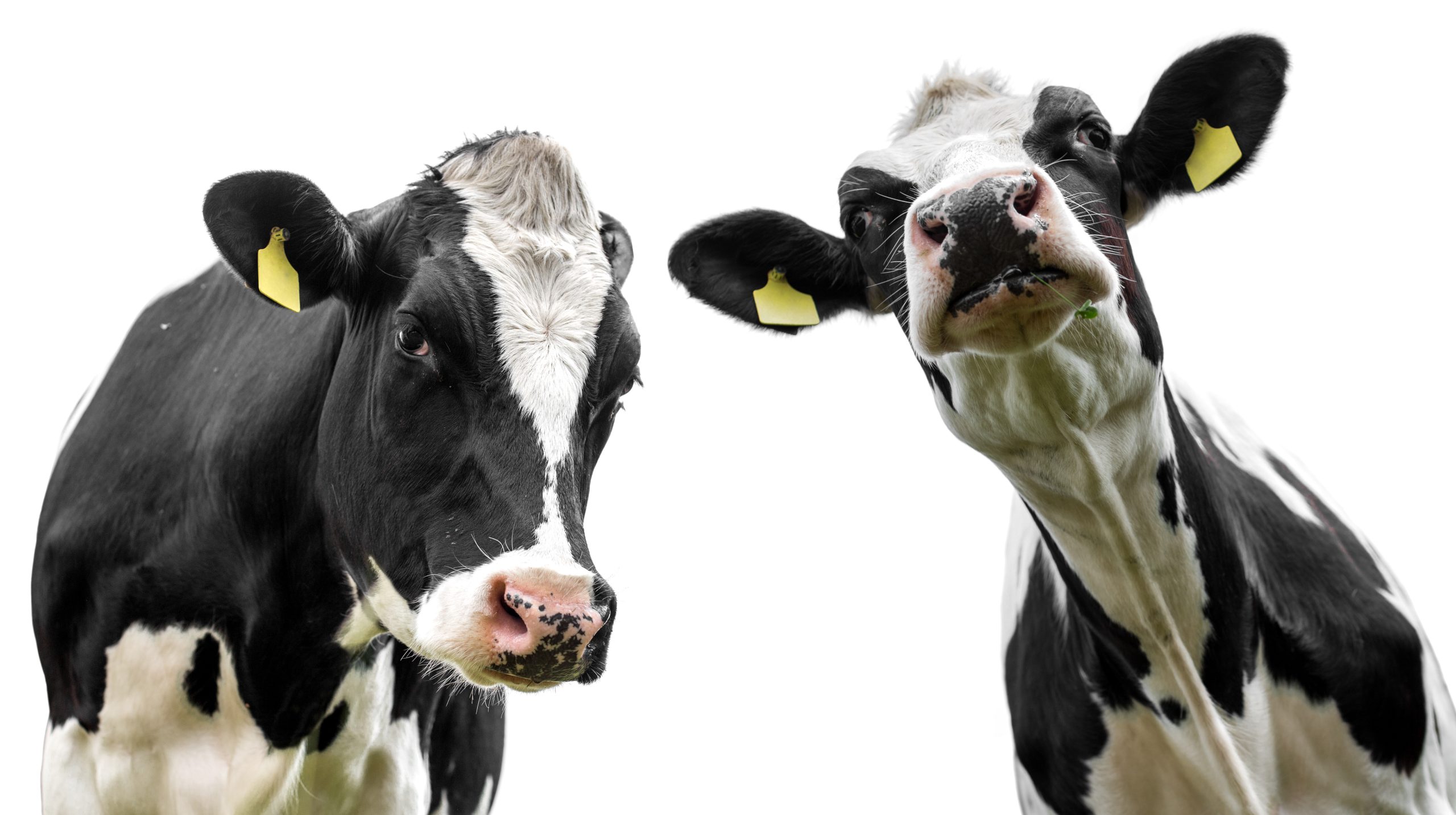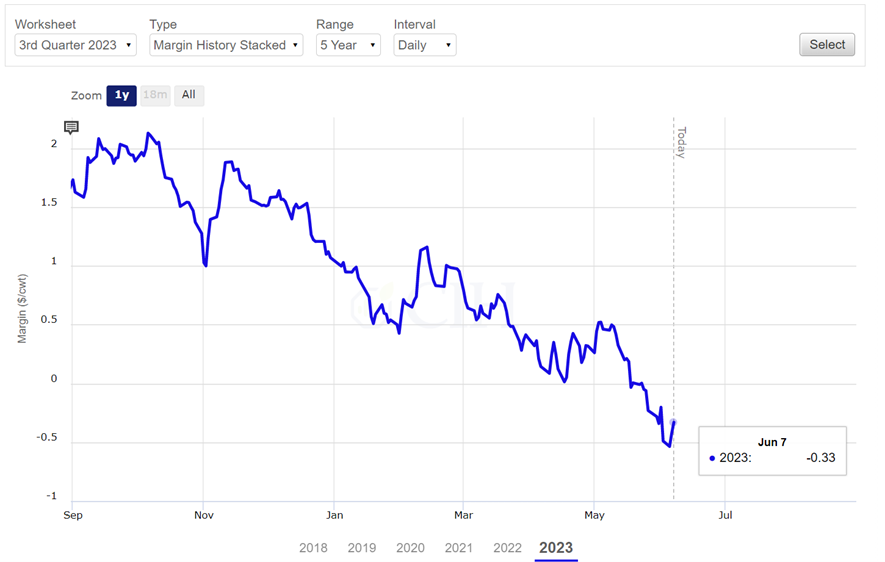
June 06, 2023
Dairy Risk Management In Commodity Hedging
There is no doubt that the dairy industry has experienced significant volatility in the past five years. Between Covid, global tensions, logistical and staffing concerns, and feed prices hitting near all-time highs, it has been difficult for dairies to realize consistent positive margins in their dairy risk management. Using the past five years as an example, Q4 open market margins (unhedged) for California dairy farmers utilizing a 50/50 Class III/IV blend have fluctuated approximately $8.00/CWT. As of today, milk prices are trending back towards the levels we saw in 2019-2021:

Dairy margins are multi-pronged with inputs from the price of milk received, non-milk revenue, and overall costs. Risk management is an important consideration when operating in a tight margin environment. The purpose of this article is to review dairy operations input costs, discuss an example of forward modeling, develop a Margin Management Plan and discuss the tools dairy farmers can utilize to optimize their risk management strategies.
Margin Inputs
Dairy margins are heavily impacted by milk prices and a major concern for dairy producers is the volatility of milk prices. For example: over the past five years, December Class III and Class IV futures prices have ranged from $15/cwt – $23.30/cwt, and $13/cwt – $24.50, respectively.
As a result, dairy industry producers who do not have a dairy risk management strategy targeting profit margins find it difficult to weather the lows.
In addition to milk volatility, feed prices are no stranger to volatility. Q4 feed prices over the past 5 years:
- December soybean meal futures: Traded between $290/ton and $457/ton before before basis
- December corn futures: Traded between $3.25/bu and $7.50/bu before basis
Using the examples above (not including other costs such as: increasing transportation, labor shortages, etc.), risk management strategies are more important than ever to ensure protection against adverse price changes. Profit margins for dairies are not static, however, often there are opportunities to protect margins 6 -18 months in advance of the actual “spot” timeframe. For example, consider a California producer with milk exposure to 50% Class III and 50% Class IV price risk. The graph below shows historical open margins for Q3 2023. Current open margins are at $-0.33/CWT while over the course of the past 9 months, there have been profit opportunities this producer could have taken advantage of and layered in coverage to captured or protected margins at over $2/CWT higher, ensuring profitability.

Looking at Q4 over the past 18 months for that same producer:

Like Q3 margins, Q4 margins have declined, but are still about $1/CWT higher than Q3 margins. There are many strategies and tools that producers can utilize to capture this positive margin and protect against market uncertainty. Since each dairy is unique, the first thing producers will need to do to optimize their risk management plan is understand their exposure and build a Margin Management Policy, tailored to their business efficiencies and long-term goals.
Margin Protection Plan
While nearby margins have deteriorated, Q4 2023 and 2024 open market margins are still opportunistic. One of the primary ways to capture these prices and mitigate the risk of exposure to market uncertainty is by establishing a Margin Management Policy. At its core, a Margin Management Policy is a statement of what a dairy producer is trying to accomplish, and how he or she will go about achieving it. Whether it is a priority such as maximizing profitability or minimizing price risk, a specific goal should be defined. Once a goal is established, the Margin Management Policy is structured top to bottom, with starting points following the goal. If the goal is to maximize profit margins, a starting point may be to define a level of profitability that is acceptable. This may be a specific return on investment, dollar figure, or percentile of historical profitability.
Once a producer has a defined starting point, it is important not only to set target levels to capture opportunities, but also to know when a target has been triggered. To set accurate targets, a dairy producer needs to take into consideration and model all its unique costs, revenues, and other factors in its operation. This should be maintained and updated regularly to reflect any changes that could impact profitability. This Margin Management Policy is a work in progress and should be modified as needed, especially if goals change.
A strong Margin Management policy will not only designate who will carry out the plan, but it will define all the methods used to contract for both purchases and sales. This will include what parties will be contracted with, capital requirements, and where the capital will come from to ensure the plan is executed.
The final stage of a strong Margin Management Policy is refining what strategies work best for the business, how to scale in protection as margins change, and at what levels will positions be offset or initiated to help protect the integrity of the plan. Understanding what events can change market dynamics and what tools can be utilized to navigate potential price risk and volatility will be key to maximizing a dairy farmer’s Margin Management Policy.
Fundamental Outlook
Reports are published about every week that may be relevant to near-term market prices. Reports such as USDA’s Cold Storage and Dairy Products shed light on the current supply of butter, cheese and dried powders compared to historical levels. Crop reports such as the weekly Crop Progress report give regular updates on how the US crop is developing and where it stands vs prior years. Knowing there is an oversupply of cheese in the domestic market, exports have dropped YoY, and the USDA is projecting the largest historical corn yield, reports can give producers a strong market opinion to make better decisions. GDT (Global Dairy Trade) highlights not only global dairy demand, but also the competitiveness of US dairy product prices.
That said, it is impossible to predict the market six to 12 months from today. Milk production can change, crop yields still are not fully known, economic factors could weigh on prices, etc. Margins, on the other hand, are calculated and based off revenue and cost inputs. While a dairy farmer cannot predict how a market will react in six to 12 months, he or she can layer in coverage based on where today’s futures prices are. Coverage amounts will be unique to each operation, and scaling coverage will allow a producer to protect some margin while still participating in the forward market.
For example, knowing today that corn planting has been successful, conditions are good, but there is still time left before harvest, a producer may look to put on 25% of their corn position. Knowing that Corn basis is down significantly YoY, it might also make sense to put on a basis contract and remain flexible on price.
On the dairy risk side, it is hard to make a bullish case for Class III. The market has had more cheese plants come online but not enough demand to offset the supply. Milk production remains strong in the Midwest, where over 50% of the Class III plants are. With this, the market needs a reduction in supply or demand needs to increase for prices to appreciate in the long term. Similar to Class III, Class IV has still sold off but is running at a premium. The west coast (most Class IV’s plants) continues to lose milk production and it does not seem like things are going to change. As one may predict, unlike cheese and whey, butter prices have remained steady and spot NFDM continues to trade close to 10 year average prices. These factors have created a wide price spread between nearby Class III and IV prices. Knowing that margins have fallen YoY, the question again becomes what level makes sense to layer in coverage?
Using current Q4 Class III and Class IV 2023 milk futures prices as an example:
 |
 |
|---|
Knowing that milk futures are high historically (average of 80th percentile), a dairy farmer might protect these attractive prices by utilizing tools like Dairy Revenue Protection (DRP Insurance) or various options strategies, allowing for flexibility if there is a market rally. Like corn coverage, layering coverage on milk will be unique to each operation. Ultimately, developing a Margin Management Policy will help give dairy producers the ability to make sound and consistent decisions. There are several strategies and tools that give the dairy producer the ability to manage their risk and continue to participate in moving markets.
Dairy Risk Management Tools
This article’s purpose is not to explain in detail every risk management tool available to producers. It is important though to highlight some of these tools and how: 1) dairy producers can incorporate them in their risk management strategies and 2) they assist producers in protecting margins.
Physical contracting in forward months is a way for producers to lock in the price that they will pay on feed or other inputs. There are several ways to contract physical feed in forward months using Grain Risk Management, but the two most common are fixed price and basis only. Fixed price contracts will protect futures and basis for a contracted volume, while a “basis only” contract will leave a dairy open to pricing futures later. Using historical price percentiles is often a good relative measure to determine the timing of a physical contract. While basis does show normal trends (historically on average corn has been more expensive in the summer vs late fall), it is important for dairies to have a grasp on their local markets as basis will change with local supply and demand changes.
Exchange traded, futures and options strategies are common tools in dairy risk management. Futures allow producers to hedge their milk or feed at a guaranteed price of a designated futures month (December futures have been used in this article). Options, on the other hand, give producers the right to protect feed or milk at a designated price for a premium. Options give dairy farmers the flexibility to participate in market movements should feed prices drop or milk prices rise.
Lastly, there are several government programs available to farmers such as Dairy Revenue Protection Insurance (DRP Insurance) or Dairy Margin Coverage Insurance (DMC Insurance). Dairy Revenue Protection (DRP) is becoming more popular among producers. DRP is comparable to option pricing strategies, in that dairies can receive a minimum price for their milk by paying a premium. There are some additional benefits to leveraging Dairy Revenue Protection (DRP Insurance):
- Cash flow: DRP Insurance premiums are due at the end of a quarter whereas both futures and options margins and premiums will be due up front.
- Subsidy: DRP Insurance premiums are subsidized by 44-55% while options strategies do not have subsidies. This puts more money in producers’ pockets while still allowing for competitive price protection.
- Pricing advantages: DRP Insurance can be priced by either class or component pricing. The main difference is component pricing is based on butterfat, nonfat solids, and protein prices. Class pricing, on the other hand, is based off Class III and IV prices. By having the flexibility of choosing either pricing mechanism, dairies can capitalize on price discrepancies rather than be susceptible to one offering.
Here is an example of what a California dairy using a 50/50 Class III and IV blend might be offered from DRP:

With Q4 2023 dairy margins falling over $4/CWT in the last year, high feed costs, and slipping milk prices, dairies should prioritize putting together a sound Margin Management Policy. There are several factors that will affect forward margins (crop yield, dairy demand, milk production, etc.) and a Margin Management Policy will be pivotal to navigating these volatile, uncertain markets.